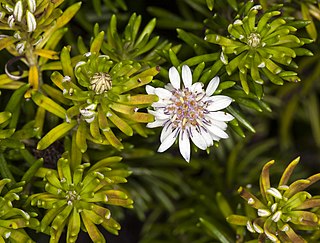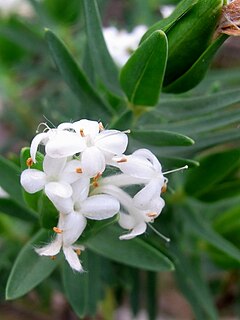
Olearia phlogopappa commonly known as the dusty daisy-bush or alpine daisy-bush is a species of flowering plant in the family Asteraceae that is commonly found in eastern New South Wales, Victoria and Tasmania. It is a small shrub with greyish-green foliage, daisy-like flowers in white, pink or mauve that can be seen from spring to late summer.

Trophis scandens, commonly named burny vine, is a species of large woody vines, constituting part of the fig plant family. They grow naturally in rainforests in Australia and Malesia.

Sarcomelicope simplicifolia, commonly known as bauerella, hard aspen or yellow-wood, is a species of flowering plant in the family Rutaceae and is endemic to eastern Australia including Lord Howe and Norfolk Islands. It is a shrub or small tree with elliptic to egg-shaped leaves arranged in opposite pairs, male or female flowers arranged in small groups in leaf axils and fruit an oval to spherical drupe.

Olearia astroloba, commonly known as Marble daisy-bush, is a rare shrub species in the family Asteraceae. It is endemic to the state of Victoria in Australia.

Olearia elliptica, commonly known as the sticky daisy bush, is a shrub in the daisy family, Asteraceae and is native to New South Wales and Queensland in eastern Australia. It has scattered, sticky leaves and white flowers in summer and autumn.

Olearia asterotricha, commonly known as rough daisy-bush, is a species of flowering plant in the family Asteraceae. A tall shrub with white, mauve or blue daisy like flowers growing from the Blue Mountains in New South Wales to western Victoria, Australia.

Boehmeria australis is a critically endangered large shrub species in the plant family Urticaceae. It is endemic to small islands of Australia and New Zealand.
Trophis scandens subsp. megacarpa is a flowering plant in the mulberry family. The subspecific epithet comes from the Greek mega ("big") and carpos ("fruit"), with reference to the larger fruits in this subspecies.

Olearia ballii, commonly known as the Mountain Daisy, is a shrub in the daisy family, Asteraceae. The specific epithet honours Lieutenant Henry Lidgbird Ball who, while commanding HMS Supply in 1788, discovered and named Lord Howe Island, where the plant was subsequently collected.
Olearia mooneyi, commonly known as pumpkin bush, is a large shrub or small tree in the daisy family, Asteraceae. The specific epithet honours Thomas Mooney (1842–1873), an early settler of Lord Howe Island who was interested in its plants.
Coprosma huttoniana is a flowering plant in the family Rubiaceae. The specific epithet honours Ian Hutton, the Lord Howe Island based naturalist who discovered the plant and recognised it as a new species.

Pimelea congesta is a flowering plant in the Thymelaeaceae family. The specific epithet refers to the congested inflorescence.

Celtis conferta subsp. amblyphylla, commonly known as cotton wood or cotton-wood, is a flowering plant in the hemp and hackberry family.
Melicytus novae-zelandiae subsp. centurionis is a flowering plant in the family Violaceae. It is a subspecies of Melicytus novae-zelandiae, known in New Zealand as coastal mahoe. The subspecific epithet honours the military Captain James Doran McComish (1881–1948), who made several visits in the 1930s to collect plants on Lord Howe Island.
Apium prostratum subsp. howense is a flowering plant in the carrot family. The subspecific epithet refers to the island to which it is endemic.

Drypetes deplanchei subsp. affinis, commonly known as greybark or grey bark, is a flowering plant in the Putranjivaceae family. The subspecific epithet affinis alludes to its similarity to Drypetes sepiaria of India and Sri Lanka.
Leptospermum polygalifolium subsp. howense, commonly known as tea tree or tea-tree, is a flowering plant in the myrtle family, Myrtaceae. The subspecific epithet refers to the island to which the subspecies is endemic.
Passiflora herbertiana subsp. insulae-howei is a flowering plant in the passion flower family. The subspecific epithet refers to the island to which the subspecies is endemic.
Piper excelsum subsp. psittacorum, commonly known as pepper tree or kava, is a flowering plant in the family Piperaceae. The subspecific epithet means “of the parrots”, inferring a liking by parrots for the fruits.
Pouteria myrsinoides subsp. reticulata, commonly known as axe-handle wood, is a flowering plant in the sapodilla family, Sapotaceae. The subspecific epithet refers to the reticulate venation on the leaves.










